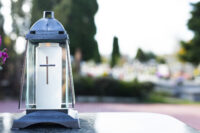
Praying for the dead can be a helpful part of the grieving process, but it’s also part of Catholic tradition to pray for those who are no longer here on Earth with us. So, where did the practice come from?
The earliest Scriptural reference to prayers for the dead comes in the second book of Maccabees. The books of Maccabees were among the latest written books found in the Old Testament, and they recount the struggle of the Jewish people for freedom against the Seleucid Empire, around 100-200 years before the birth of Christ. As such, they are written from an Orthodox Jewish point of view. The second book of Maccabees tells how Judas Maccabee, the Jewish leader, led his troops into battle in 163 B.C. When the battle ended, he directed that the bodies of those Jews who had died to be buried. As soldiers prepared their slain comrades for burial, they discovered that each was wearing an amulet taken as booty from a pagan Temple. This violated the law of Deuteronomy and so Judas and his soldiers prayed that God would forgive the sin these men had committed (II Maccabees 12:39-45).
This is the first indication in the Bible of a belief that prayers offered by the living can help free the dead from any sin that would separate them from God in the life to come. It is echoed in the New Testament when Paul offers a prayer for a man named Onesiphorus who had died: “May the Lord grant him to find mercy from the Lord on that day” (II Timothy 1:18). The cave-like tombs under the city of Rome, which we call catacombs, also bear evidence that members of the Roman Christian community gathered there to pray for their fellow followers of Christ who lay buried there. By the fourth century, prayers for the dead are mentioned in Christian literature as though they were already a longstanding custom.
RELATED: What is All Souls Day?
The practice of praying for the dead is rooted first in Christian belief in the everlasting life promised in Jesus’ teachings and foreshadowed by his disciples’ experience that God had raised him from the dead. After death, even though separated from our earthly body, we yet continue a personal existence. It is as living persons that God invites us into a relationship whose life transcends death.
Praying for the dead has further origins in our belief in the communion of saints. Members of this community who are living often assist each other in faith by prayers and other forms of spiritual support. Christians who have died continue to be members of the communion of saints. We believe that we can assist them by our prayers, and they can assist us by theirs.
Related: How Do I Pray to Saints Without Worshipping Them?
Our prayers for the dead begin at the moment of death. Often family members will gather in prayer around the bedside of the person who has died. The Order of Christian Funerals includes a Vigil Service for the deceased, which can be held in the home, in the church, or in a funeral home chapel, the funeral Mass and the Rite of Committal (which generally takes place at the burial site). The prayers express hope that God will free the person who has died from any burden of sin and prepare a place for him or her in heaven. Death remains a mystery for us–a great unknown. Yet Christian language evokes a hopeful imagination in the presence of death, an assurance that our love, linked to Christ’s love, can help bridge whatever barriers might keep those whom we love from fully enjoying the presence of a loving and life-giving God.